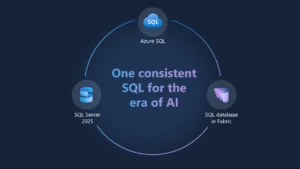Announcing the retirement of SQL Server Stretch Database
Ever since Microsoft introduced SQL Server Stretch Database in 2016, our guiding principles for such hybrid data storage solutions have always been affordability, security, and native Azure integration. Customers have indicated that they want to reduce maintenance and storage costs for on-premises data, with options to scale up or down as needed, greater peace of mind from advanced security features such as Always Encrypted and row-level security, and they seek to unlock value from warm and cold data stretched to the cloud using Microsoft Azure analytics services.
During recent years, Azure has undergone significant evolution, marked by groundbreaking innovations like Microsoft Fabric and Azure Data Lake Storage. As we continue this journey, it remains imperative to keep evolving our approach on hybrid data storage, ensuring optimal empowerment for our SQL Server customers in leveraging the best from Azure.
Retirement of SQL Server Stretch Database
On November 16, 2022, the SQL Server Stretch Database feature was deprecated from SQL Server 2022. For in-market versions of SQL Server 2019 and 2017, we had added an improvement that allowed the Stretch Database feature to stretch a table to an Azure SQL Database. Effective July 9, 2024, the supporting Azure service, known as SQL Server Stretch Database edition, is retired. Impacted versions of SQL Server include SQL Server 2022, 2019, 2017, and 2016.
In July 2024, SQL Server Stretch Database will be discontinued for SQL Server 2022, 2019, 2017, and 2016. We understand that retiring an Azure service may impact your current workload and use of Stretch Database. Therefore, we kindly request that you either migrate to Azure or bring their data back from Azure to your on-premises version of SQL Server. Additionally, if you’re exploring alternatives for archiving data to cold and warm storage in the cloud, we’ve introduced significant new capabilities in SQL Server 2022, leveraging its data virtualization suite.
The path forward
SQL Server 2022 supports a concept named CREATE EXTERNAL TABLE AS SELECT (CETaS). It can help customers archive and store cold data to Azure Storage. The data will be stored in an open source file format named Parquet. It operates well with complex data in large volumes. With its performant data compression, it turns out to be one of the most cost-effective data storage solutions. Using OneLake shortcuts, customers then can leverage Microsoft Fabric to realize cloud-scale analytics on archived data.
Our priority is to empower our SQL Server customers with the tools and services that leverage the latest and greatest from Azure. If you need assistance in exploring how Microsoft can best empower your hybrid data archiving needs, please contact us.
New solution FAQs
What’s CETaS?
Creates an external table and then exports, in parallel, the results of a Transact-SQL SELECT statement.
- Azure Synapse Analytics and Analytics Platform System support Hadoop or Azure Blob Storage.
- SQL Server 2022 (16.x) and later versions support CETaS to create an external table and then export, in parallel, the result of a Transact-SQL SELECT statement to Azure Data Lake Storage Gen2, Azure Storage Account v2, and S3-compatible object storage.
What is Fabric?
Fabric is an end-to-end analytics and data platform designed for enterprises that require a unified solution. It encompasses data movement, processing, ingestion, transformation, real-time event routing, and report building. Fabric offers a comprehensive suite of services including Data engineering, Data Factory, Data Science, Real-Time Analytics, Data Warehouse, and Databases.
With Fabric, you don’t need to assemble different services from multiple vendors. Instead, it offers a seamlessly integrated, user-friendly platform that simplifies your analytics requirements. Operating on a software as a service (SaaS) model, Fabric brings simplicity and integration to your solutions.
Fabric integrates separate components into a cohesive stack. Instead of relying on different databases or data warehouses, you can centralize data storage with Microsoft OneLake. AI capabilities are seamlessly embedded within Fabric, eliminating the need for manual integration. With Fabric, you can easily transition your raw data into actionable insights for business users.
What is OneLake shortcuts?
Shortcuts in OneLake allow you to unify your data across domains, clouds, and accounts by creating a single virtual data lake for your entire enterprise. All Fabric experiences and analytical engines can directly connect to your existing data sources such as Azure, Amazon Web Services (AWS), and OneLake through a unified namespace. OneLake manages all permissions and credentials, so you don’t need to separately configure each Fabric workload to connect to each data source. Additionally, you can use shortcuts to eliminate edge copies of data and reduce process latency associated with data copies and staging.
Shortcuts are objects in OneLake that point to other storage locations. The location can be internal or external to OneLake. The location that a shortcut points to is known as the target path of the shortcut. The location where the shortcut appears is known as the shortcut path. Shortcuts appear as folders in OneLake and any workload or service that has access to OneLake can use them. Shortcuts behave like symbolic links. They’re an independent object from the target. If you delete a shortcut, the target remains unaffected. If you move, rename, or delete a target path, the shortcut can break.
Learn more
- Stretch Database
- Deprecated database engine features in SQL Server 2022
- Install an on-premises data gateway
- SQL Server in Microsoft Fabric? Use CETaS to move data!
- OneLake shortcuts
- CREATE EXTERNAL TABLE AS SELECT (CETaS)


